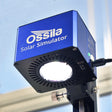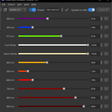Individual LED Lamp with Spectral Tunability
Easy to integrate into existing or custom systems
Overview | Specifications | Features | Software | Gallery | Resources and Support
Integrate a high power light source into your testing setup with this low cost LED lamp. The reliable, calibrated output is optimized to meet the solar spectrum for a Class AAA rating over a 15 mm diameter circular area for small device testing (using the latest IEC 60904-9:2020 International Standard). For your larger area testing setup, the lamp has a Class B spatial non-uniformity rating for areas up to 25 mm in diameter, and a Class C rating for diameters up to 32 mm.
Control each LED output individually and change the total irradiance output with our free software. Plus, the lamp can now be calibrated to test indoor photovoltaics according to the new IEC TS 62607-7-2:2023 standard.
Why Choose an LED Lamp?
LED solar simulators offer several advantages over arc lamp solar simulators. They are cheap to run with high efficiency LED lights and require zero maintenance. Arc lamps, by comparison, waste a considerable amount of energy as heat and need at least 30 minutes to warm up. The Ossila LED Solar Simulator Lamp is ready to use just a few minutes after you turn it on.
Long Lifetime
10,000 operating hours
Minimal Warm-up Time
Highly efficient LED bulb
Spectral Tunability
Tune with powerful software
Compact Size
Integrate into your setup
Specifications
| Spectral match | A |
|---|---|
| Spatial uniformity over 15 mm diameter area | A |
| Spatial uniformity over 25 mm diameter area | B |
| Spatial uniformity over 32 mm diameter area | C |
| Temporal instability | A |
| Type | LED-Based, Steady State |
|---|---|
| Spectral Deviation | <70% |
| Spectral Coverage | >80% |
| Working Distance | 8.5 cm (3.35") |
| Irradiance (at working distance) | 1000 W/m2 |
| Wavelength Range | 350 nm - 1000 nm |
| Maximum Lamp Time | 10000 hours |
| Dimensions (L x W x H) | 10.5 cm x 9.0 cm x 8.0 cm (4.13" x 3.54" x 3.15") |
| Weight | 600 g (1.32 lbs) |
LED Solar Simulator Lamp Features

Easy to Integrate
A cost-effective choice for implementing a reliable, high power spectrum in your custom testing setup. Mount the lamp using the attached bracket to expand your research capabilities in photosensitive applications. The small footprint is perfect for your busy laboratory or confined workstations where space is limited.

Reliable LED Light Source
The LED solar simulator has a calibrated array of light-emitting diodes to reliably and accurately mimic the solar spectrum. Take advantage of a lamp with a long lifetime, good temporal stability, low running costs, zero maintenance, spectral tunability, and no explosion risk.

Adaptable Spectrum
Calibrated to deliver an output optimized to meet the solar spectrum, you can start testing straight away. With easy-to-use software, you can also control each LED output individually and change the total irradiance output. As of 2024, our system can also be calibrated to test indoor photovoltaics according to newly defined standards.
Software
The Ossila Solar Simulator Console enables you to control and customize the output of your LED solar simulator. You can choose the overall power level or control each LED individually to tailor the output to your specific requirements. The user-friendly software can be installed on as many PCs as you want and you can access future updates for free.
You can also control the lamp using a serial command library. This can be useful for specialist measurements or non-conventional spectral output.

Software Requirements
| Operating System | Windows 11 (64-bit) |
|---|---|
| CPU | Dual Core 2 GHz |
| RAM | 4 GB |
| Available Drive Space | 152 MB |
| Monitor Resolution | 1440 x 960 |
| Connectivity | USB |
LED Solar Simulator Lamp Gallery
Additional Specifications
Classification
Spectral Irradiance
The programmed spectral irradiance of the LED solar simulator is at 1 Sun (left). Automatically, the lamp emits a total integrated power of 100 mW/cm2 (1 Sun) over the wavelength range 350 nm – 1000 nm. Our LED solar simulator achieves a Class A rating within each wavelength range for small area devices.
The Ossila LED Solar Simulator also allows you to adapt the output spectrum of your lamp as you desire. The graph on the right shows a spectral distribution at 0.7 Suns. This matches the AM 1.5G spectral shape, accounting for the portion above 1000 nm.
Spectral Match
The spectral match classification measured how well a solar simulator replicates the solar spectrum in terms of wavelength distribution. At 1 Sun irradiance at 8.5 cm, the Ossila LED Solar Simulator Lamp acheives Class A output in all wavelegnth catagories. At this irradiance, the Ossila LED Solar Simulator Lamp achieves a Class A classification for spectral irradiance.
Spatial Uniformity
Solar simulators aim to distribute light uniformly across a sample, replicating sunlight. The spatial uniformity rating gives a measure of how uniform a solar simulator's distribution is.
At the working distance of 8.5 cm and output power of 1 sun, the Ossila LED Solar Simulator Lamp achieves a spatial non-uniformity class A rating over a 15 mm diameter, making it ideal for testing small area devices. It also achieves a class B rating over 25 mm diameter, and a class C rating at 32 mm diameter, so you also can test larger cells with the Ossila LED solar simulator Lamp with ABA or ACA classification.
Temporal instability
The temporal instability classification measures the output consistency of a solar simulator.
The temporal instability graph proves that the light output from the solar simulator is stable over a long time frame, so it achieves a Class A Temporal Instability classification. This means you can conduct long-term experiments with the Ossila LED Solar Simulator Lamp without worrying about spectral fluctuation. This includes measurement such as solar cell lifetime measurements or experiments to measure light degradation effects.
Mounting information
The solar simulator lamp comes with a permanent mounting bracket attached to the rear. This can be used to afix the lamp to a custom gantry. The dimensions and spacing of the mounting holes are shown below. All holes are unthreaded.

Resources and Support
 Solar Simulator Light Sources
Solar Simulator Light Sources
Choosing the right light source for your solar simulator is one the most important decisions to make when setting up a PV testing laboratory.
Read more...




